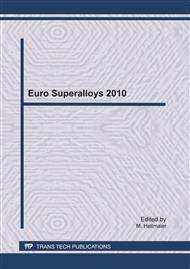p.54
p.60
p.66
p.72
p.78
p.84
p.90
p.96
p.102
Secondary Reaction Zone Formations in Pt-Aluminised Fourth Generation Ni-Base Single Crystal Superalloys
Abstract:
Fourth generation superalloys are characterised by the addition of Ru which contributes to improved creep resistance whilst improving the microstructural stability. However, Ru additions have a negative effect on coated Ni-base superalloys, promoting Secondary Reaction Zone (SRZ) formation. Formation of a layer of SRZ beneath an aluminised or Pt-aluminised coating has the potential to reduce the effective cross section of a blade by in excess of 100 μm or 10% of the wall thickness. In this paper the effects of alloy composition on the formation of the SRZ in Pt-Aluminised fourth generation alloys were investigated systematically. A series of experimental fourth generation alloys was used having two distinct compositions of Co, Mo, W and Ru and conforming to a four factorial 'Design of Experiments' model. These alloys showed significant and consistent changes in the SRZ depending on alloy composition. These were in distinct contrast to the effects of these elements on stability in the bulk. Mo was demonstrated to be by far the most effective element suppressing SRZ formation, followed by Co. In contrast, both W and Ru enhance SRZ formation.
Info:
Periodical:
Pages:
78-83
Citation:
Online since:
July 2011
Authors:
Keywords:
Permissions:
Share:
Citation:


